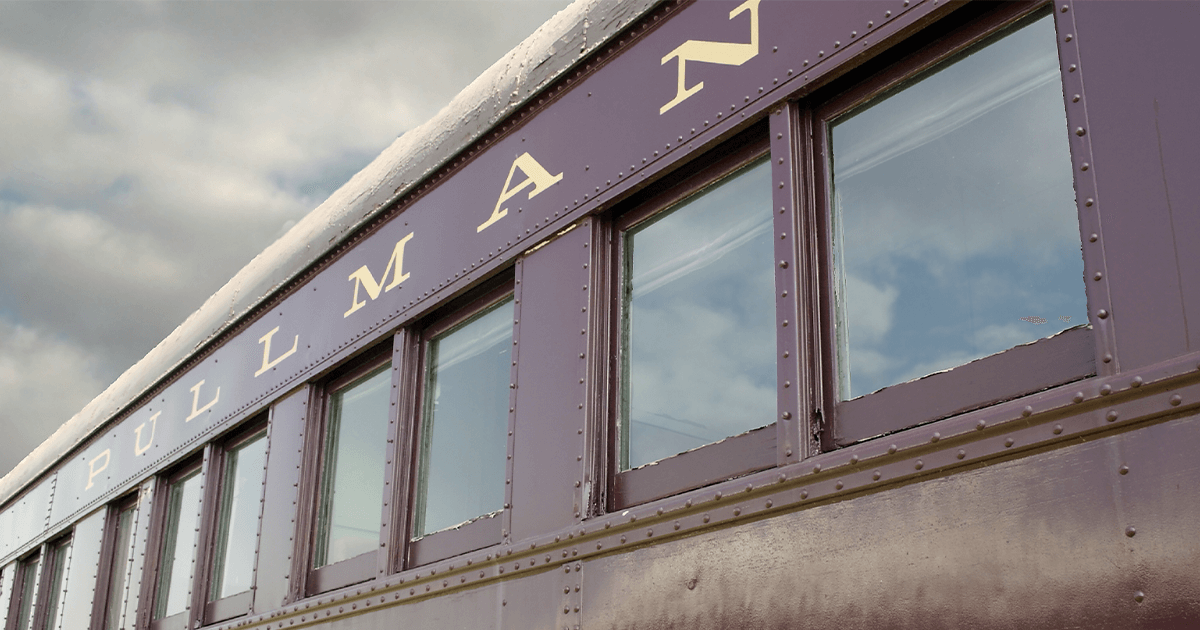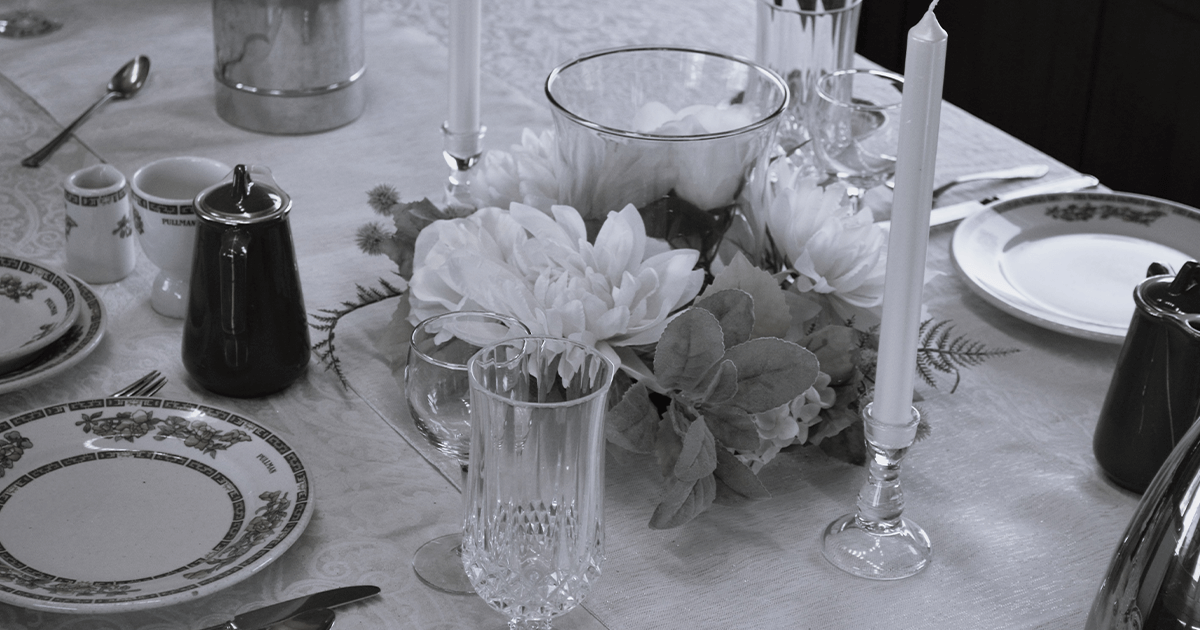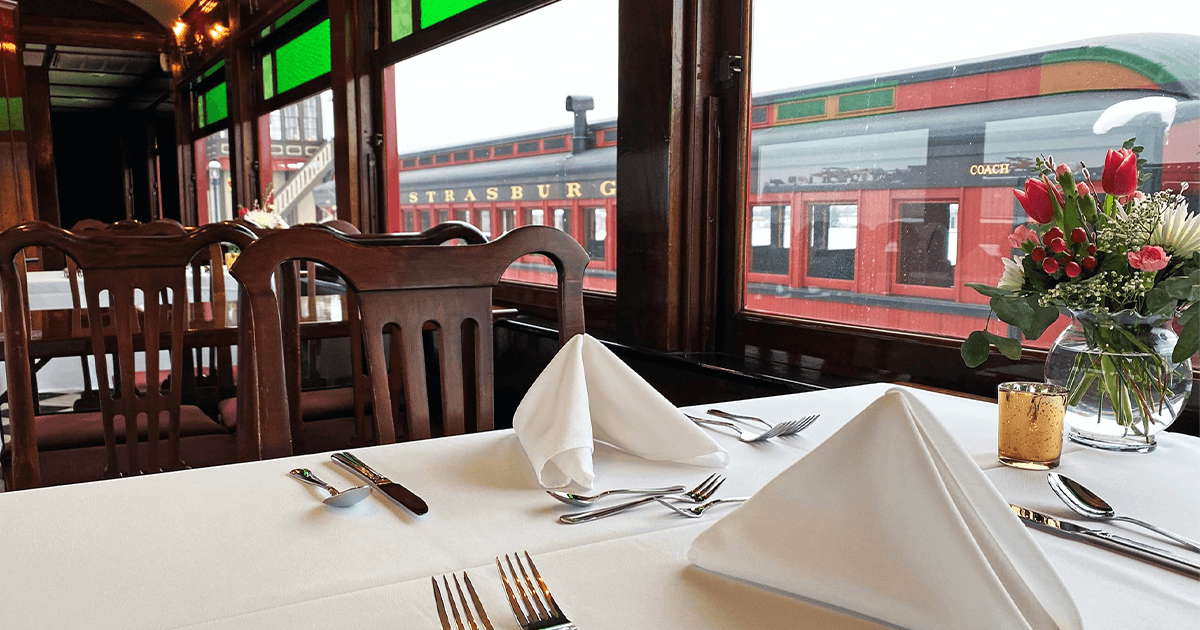THE RICH HISTORY OF TRAIN CAR DINING

When passenger trains came into popular use, train car dining didn’t exist. It wasn’t until later, after the Civil War, that dining became a regular feature of train transit.
As dining cars and the food they served continued to improve, train car dining started to rival some of the best five-star restaurants across the country. Discover the unique history of dining on the train, plus where you can experience it for yourself!
The Need For Train Car Dining
In the early days of passenger travel by train, there were no food or drink options available to passengers. At the time, however, it wasn’t needed; most railroad tracks were only a few miles long, so train rides were short enough that passengers could eat or drink after the train arrived at their destination.
Take the Best Friend of Charleston, for instance. This was the first passenger train that successfully transported a full train of passengers from point A to point B in South Carolina. The track was only 6 miles long.
The success of the Best Friend of Charleston, however, kicked off the growth of passenger trains across the country. By the early 1940s, over 2,000 miles of railroad tracks were built and trains could travel further distances.
It was then that the need for train car dining became more prevalent. Since train transit was still considered new, trains had to stop every hundred miles to restock their wood and water supply.
During these stops, train personnel allowed passengers to deboard the train to purchase something to eat or drink at local restaurants or roadhouses. With limited food options and time, this often resulted in a mad dash to quickly buy and eat whatever was available.
To improve the experience for train passengers, railway companies explored other options like station houses. These were located directly on the railway terminal so train passengers didn’t have to rush to a local restaurant and back just for a bite to eat.
Some station houses learned to be highly efficient, like the Fred Harvey Houses. Yet, they still all faced the common enemy: time.
The existence of station houses didn’t change the fact that passengers only had 20 minutes to deboard, eat, and reboard the train. Railways needed to find a better way to accommodate their passengers.

Pullman’s Impact On Train Car Dining
If there was anyone who understood the need for increased comfort on railroad train cars it was George Pullman. Pullman was a 19th-century industrialist and founder of the Pullman Palace Car Company.
His company was created with the intent of bringing the comfort and luxury of modern amenities to railroad cars. Pullman introduced the first sleeping car to railroads in the mid-1860s, which eventually paved the way for the creation of the hotel car just two years later.
The hotel car was the first train cab designed to prepare food on the train. It was equipped with a small 3-by-6-foot kitchen operated by crews of four to five, but seating options were still limited.
The following year, the Pullman Company introduced the first all-dining car, the “Delmonico.” Named after the critically acclaimed restaurant in New York City, the Delmonico offered two full dining rooms with a kitchen in between.
The Delmonico screamed luxury. These cars were typically carpeted and sometimes even decorated with draperies, elaborate light fixtures, and upholstered chairs. Tables were set for fine dining, with expensive linens and kitchenware.
In total, the Delmonico could seat up to 36 people at a time. Between cooks, waiters, and busboys, the dining car required a large staff of at least seven, but often over 10.
The Dining Car Menu
With a full kitchen staff working on the Delmonico, the menu items on the dining car were essentially limitless. They were able to prepare and serve meat products, soups, salads, bread, desserts, and cocktails.
The logistics of preparing food on a moving train car with limited space did cause a greater challenge.
Though menus could be expansive, most railroads were known for serving a specialty, signature dish. The dish was selected based on the train’s route. For instance, Pennsylvania Railroad’s signature was Pennsylvania Dutch Shoo-Fly Pie.
Other popular specialties included:
- Golden Dollar French Toast on the Missouri Pacific
- Salad Bowls on the Southern Pacific
- Georgia Peaches on the Southern Railway
- Chicken à la Century on New York Central
- Potato Pancakes on Chicago & North Westerns
If you’re interested in learning more about the menu items that were served aboard the train, James D. Porterfield features over 330 recipes in his book, “Dining By Rail.”
The Decline Of Train Car Dining
Though the dining car was widely successful in the eyes of train passengers, many railroad companies were losing money by running these trains on their fleet.
The initial costs of building these cars were expensive. When additional costs like paying work crews and restocking food and dining necessities were factored in, dining cars cost a fortune.
In order to break even, dining cars would have had to raise menu prices higher than the finest restaurants and hotels across the country. Railroad companies knew this wasn’t a feasible option.
As time passed, train ridership started to dwindle. With the Great Depression followed by World War II, there was less of a need to travel across the country by train. Most travel was intercity, which Amtrak took over in the early 1970s.
When Amtrak took over, formal meal services were replaced with smaller refreshments and snacks, putting an end to first-class dining on the train.

Train Car Dining Timeline
This timeline summarizes the history of train car dining, calling out the most notable moments throughout the years.
1819: The Idea Of Train Car Dining Is Recorded
Though the dining car wasn’t created until later in the 1860s, the idea of train car dining was recorded in a letter by Benjamin Dearborn in 1819. Dearborn was an American printer, industrialist, and inventor.
In a written memorial letter to the U.S. Congress, he birthed the idea of eating meals on the train, writing, “A network of railroads should be constructed that offered the choice of on-board meals.”
Around 15 years later, his idea blossomed into a full-blown reality, so even though he didn’t create the dining car, his name is vital to the conversation.
The 1835s: First “Food-Focused” Car Was Created
In 1935, “The Victory” was created. This was the first train car that was built around the need for train car dining. It introduced tables, chairs, and some storage shelving. Train car passengers had the option to sit and enjoy some refreshments, but there was no formal place to prepare meals on the train car.
1842: First Recorded Meal Aboard The Train
The first record of a meal being enjoyed on a train dates back to 1842 when the Baltimore & Ohio Railroad’s President and Board of Directors were served a cold meal on the train. Food wasn’t served regularly on the train until the 1860s after the start of the Civil War.
1853: The First Refreshment Car Ran
The Baltimore & Ohio Railroad ran the first refreshment car, offering drink services to train passengers. (This was an isolated incident that wasn’t repeated on other trains until after the Delmonico was created.)
1866: The Pullman Hotel Car Was Introduced
The Pullman Company unveiled the “Hotel Car,” equipped with a small kitchen to prepare items for train passengers. Seating was still limited.
1868: Pullman Launched The First Full-Service Dining Car, Delmonico
The most important year for train car dining! The year that proved dining aboard the train wasn’t just possible, but had tremendous potential.
1876: Regularly Scheduled Dining Was Introduced
Michigan Central Railroad was the first to run regularly scheduled dining cars. Others quickly followed their lead.
1889: Most Railroads Had A Dining Car
Many companies were hesitant to run train cars at first because of the cost to build and maintain them. By the late 80s, competition for customers converted most companies to run dining cars in their fleet.
1937: Dining Costs Started To Outweigh Their Benefits
Dining on the train was still popular, but railroad companies were struggling to keep up. On average, trains were losing close to $1 million with every meal sold.
1957: Dining Costs Climbed Even Higher & Railroads Were Competing With Newer Travel Options
By 1957, the average loss per plate rose to 29 million dollars. At that point, breaking even was unmanageable.
Also during this time, railroad companies were competing with newer forms of transportation for the first time like buses, automobiles, and airplanes.
1971: Amtrak Took Over Rail Travel
Cross-country travel no longer uses trains as the preferred means of transportation, and Amtrak takes ownership of intercity rail travel.
1983: The End Of An Era; Traditional Train Car Dining Officially Died
Formal dining options are no longer offered on train cars and are replaced with vending machines and snack cars. *Some Amtrak cars have started to offer traditional tablecloth dining again.

Is Train Car Dining Available Today?
The excitement of traditional train car dining can still be experienced today on excursions or special event trains. If you’re along the East Coast, Strasburg Rail Road has plenty of dining options available for guests.
Purchase tickets to enjoy lunch or dinner in a fully restored dining car! The Dining Car runs throughout the year on most weekdays and weekends. The menu rotates quarterly with new dishes to choose from each season.
Another popular regularly scheduled dining event on the train is Strasburg’s Wine & Cheese trains. These run most weekends throughout the year, and on weekdays throughout the summer and fall seasons.
You can also find seasonal meals aboard the train, like a Mother’s Day Brunch or Santa’s Paradise Express Brunch!
But that’s not all! In 2023, Strasburg Rail Road launched its first fine dining experience on the train! Passengers can enjoy a sophisticated meal catered by a First-Class attendant. Dates for this train happen periodically throughout the year.
Want to relive some of the excitement of train car dining history? Book tickets to Strasburg Rail Road for a classic dining experience.

 Join
Join 